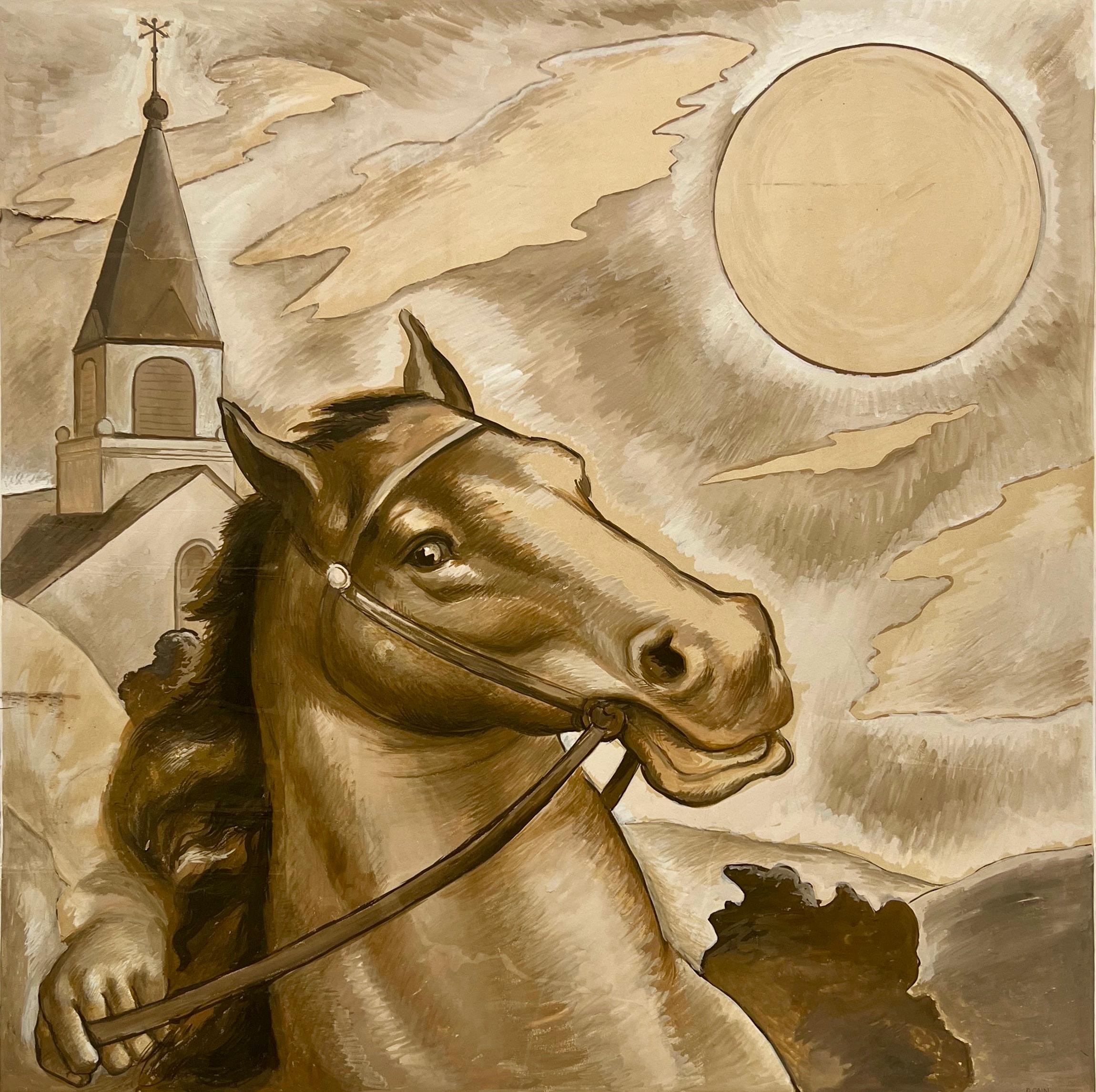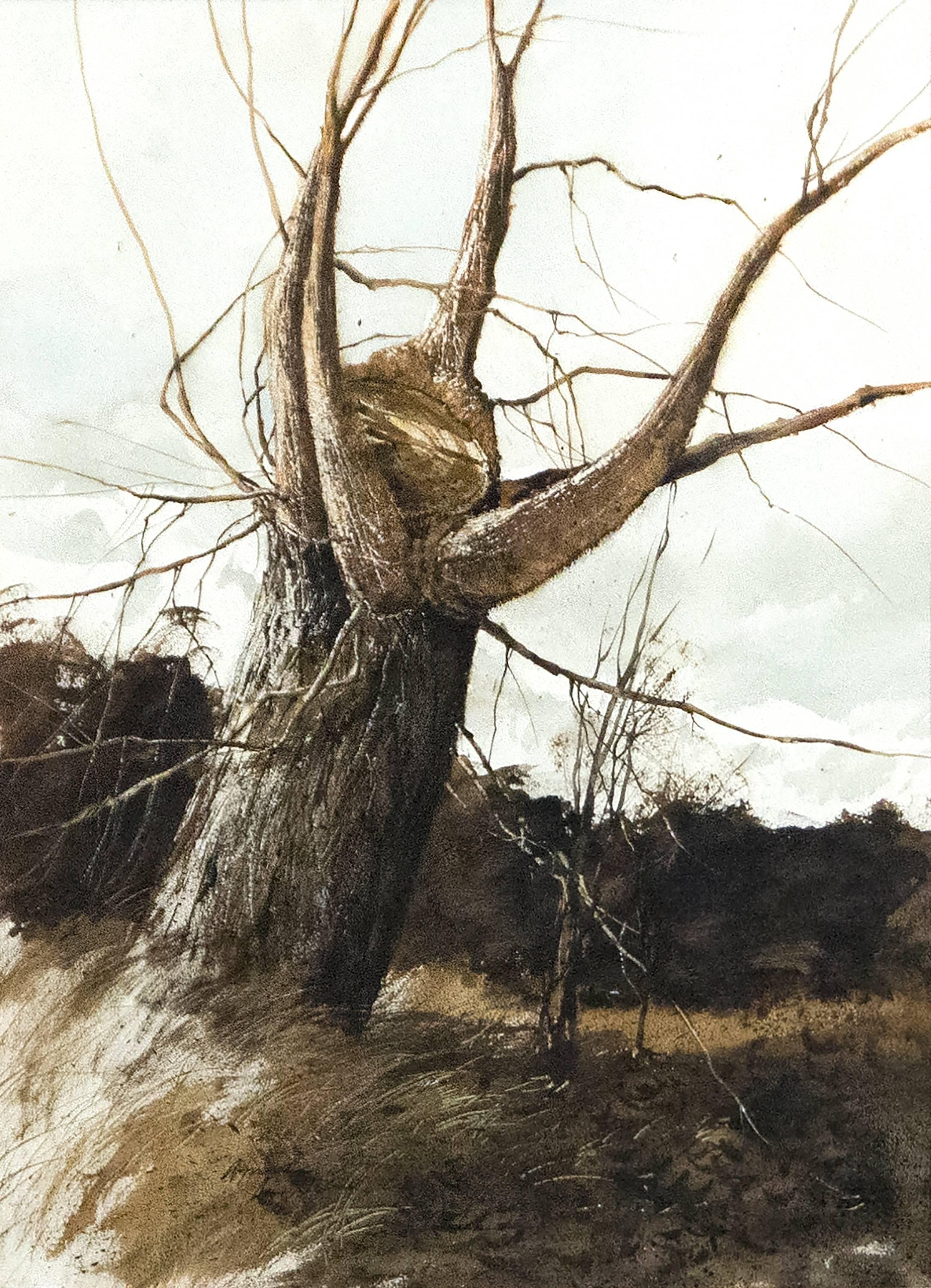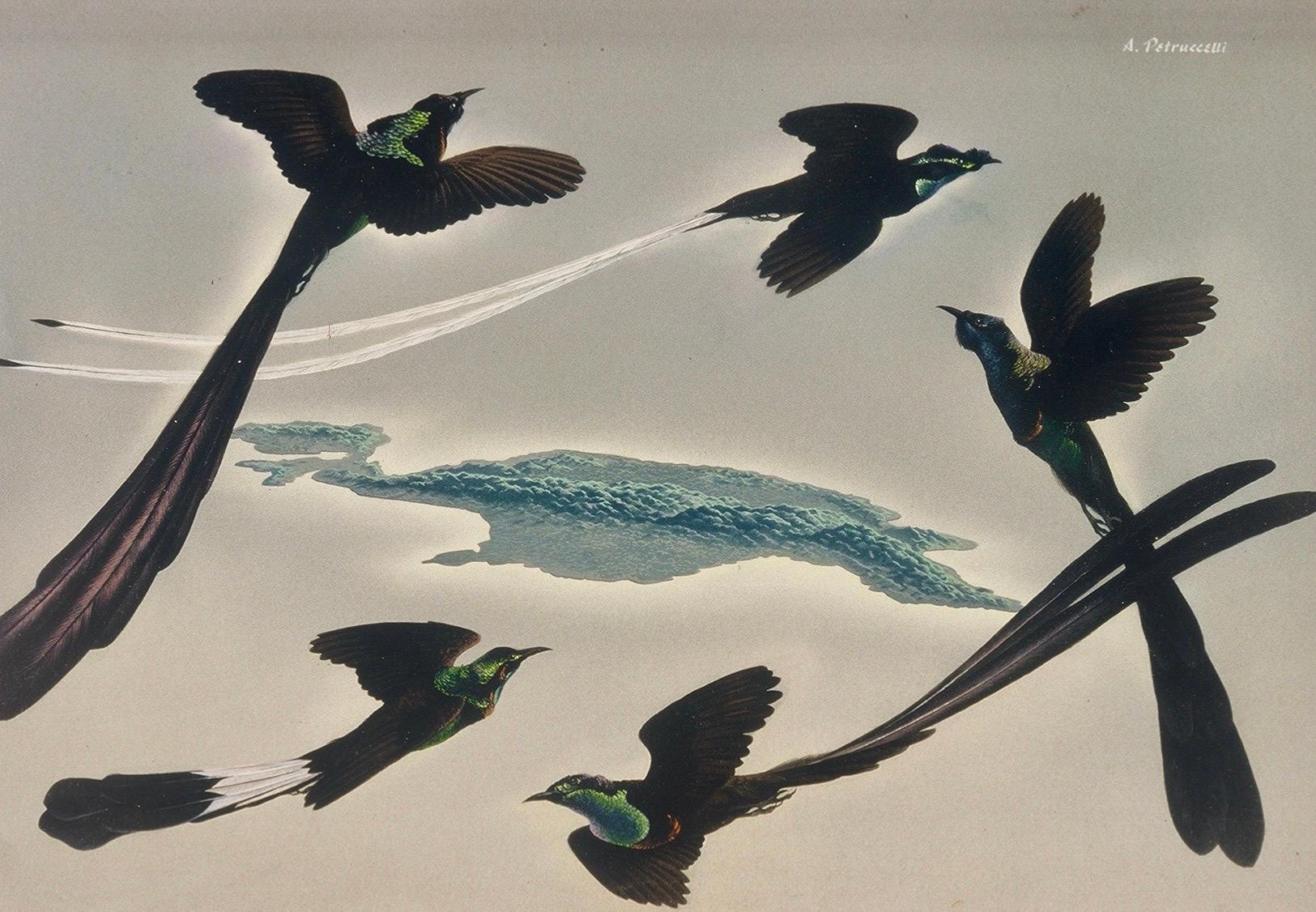Items Similar to Tree Trunk and Barn
Want more images or videos?
Request additional images or videos from the seller
1 of 8
Gregory SumidaTree Trunk and Barn1972
1972
About the Item
A watercolor by Gregory Sumida. "Tree Trunk and Barn" is a watercolor on pressed board executed in earthy browns, yellows, whites and blues and depicting a bare branched, tree trunk against an weathered, brown barn, set in a landscape of dried yellow grasses and a hazy blue sky by American Realist Gregory Sumida. Signed lower left, "G. Sumida '72."
Provenance:
Private Collection, Arizona
- Creator:Gregory Sumida (1948, American)
- Creation Year:1972
- Dimensions:Height: 24 in (60.96 cm)Width: 30 in (76.2 cm)
- Medium:
- Movement & Style:
- Period:
- Condition:
- Gallery Location:Palm Desert, CA
- Reference Number:
About the Seller
4.8
Recognized Seller
These prestigious sellers are industry leaders and represent the highest echelon for item quality and design.
Established in 1996
1stDibs seller since 2011
101 sales on 1stDibs
Typical response time: 6 hours
- ShippingRetrieving quote...Ships From: Palm Desert, CA
- Return PolicyA return for this item may be initiated within 7 days of delivery.
More From This SellerView All
- VacatedBy Gregory SumidaLocated in Palm Desert, CAA watercolor by Gregory Sumida. "Vacated" is a watercolor on watercolor board executed in blues, yellows, greens, browns and whites and depicting a dilapidated and abandoned home set...Category
1970s American Realist Landscape Drawings and Watercolors
MaterialsBoard, Watercolor
- Approaching Storm, New BranchesBy Gregory SumidaLocated in Palm Desert, CAA watercolor by Gregory Sumida. "Approaching Storm, New Branches" is a watercolor on watercolor board, executed in dark browns, greens and blues and depicting a tree trunk with bare ...Category
1970s American Realist Landscape Drawings and Watercolors
MaterialsBoard, Watercolor
- Distant Shade, Knights Ferry, CABy Gregory SumidaLocated in Palm Desert, CAA watercolor by Gregory Sumida. "Distant Shade, Knights Ferry, CA" is a watercolor, executed in earthy yellows, browns, blues and greens and depicting a California landscape of rolli...Category
1970s American Realist Landscape Drawings and Watercolors
MaterialsWatercolor
- BranchesBy Gregory SumidaLocated in Palm Desert, CAA watercolor by Gregory Sumida. "Branches" is a watercolor on paper executed in browns, greens, yellows and blue and depicting a tree trunk with bare branches set against a landscape...Category
1970s American Realist Landscape Drawings and Watercolors
MaterialsWatercolor, Paper
- Fence SupportBy Gregory SumidaLocated in Palm Desert, CAA watercolor by Gregory Sumida. "Fence Support" is a watercolor executed in greens, blues yellows and browns and depicts a pair of barren trees against a barbed wire fence...Category
1970s American Realist Landscape Drawings and Watercolors
MaterialsWatercolor
- SupportedBy Gregory SumidaLocated in Palm Desert, CAA watercolor by Gregory Sumida. "Supported" is a watercolor on watercolor board executed in earthy browns, blues, greens, yellows and white and depicts a cut tree trunk with dry, bar...Category
1970s Landscape Drawings and Watercolors
MaterialsBoard, Watercolor
You May Also Like
- Bronx Post Office Mural Study WPA Horse Social Realism Mid 20th Century ModernBy Jo CainLocated in New York, NYBronx Post Office Mural Study WPA Horse Social Realism Mid 20th Century Modern Jo Cain (1904 - 2003) Couriers of History Bronx Post Office Mural Study Horse in the Sun (with two ad...Category
1930s American Realist Animal Drawings and Watercolors
MaterialsInk, Gouache, Board
- Environmental Prognostication Coil Narrative "Homo Sapiens R.I.P."Located in Miami, FL"They paved paradise and put up a parking lot," Joni Mitchell said. - - Created in 1969, at the dawn of the American environmental movement, artist Richard Erdoes draws a sequential narrative in the form of a coil. From inception to destruction, it illustrates a list of things that humans are doing to destroy the world we live in. The work was commissioned for school-age humans and executed in a whimsically comic way. Yet the underlying narrative is sophisticated and foreshadows a world that could be on the brink of ecological disaster. Graphically and conceptually, this work exhibits an endless amount of creativity and Erdoes cartoony style is one to fall in love with. Signed lower right. Unframed 12.4 inches Width: 12.85 inches Height is the live area. Board is 16x22 inches. Richard Erdoes (Hungarian Erdős, German Erdös; July 7, 1912 – July 16, 2008) was an American artist, photographer, illustrator and author. Early life Erdoes was born in Frankfurt,to Maria Josefa Schrom on July 7, 1912. His father, Richárd Erdős Sr., was a Jewish Hungarian opera singer who had died a few weeks earlier in Budapest on June 9, 1912.After his birth, his mother lived with her sister, the Viennese actress Leopoldine ("Poldi") Sangora,He described himself as "equal parts Austrian, Hungarian and German, as well as equal parts Catholic, Protestant and Jew..."[4] Career He was a student at the Berlin Academy of Art in 1933, when Adolf Hitler came to power. He was involved in a small underground paper where he published anti-Hitler political cartoons which attracted the attention of the Nazi regime. He fled Germany with a price on his head. Back in Vienna, he continued his training at the Kunstgewerbeschule, now the University of Applied Arts, Vienna.[5] He also wrote and illustrated children's books and worked as a caricaturist for Tag and Stunde, anti-Nazi newspapers. After the Anschluss of Austria in 1938 he fled again, first to Paris, where he studied at the Academie de la Grande Chaumiere, and then London, England before journeying to the United States. He married his first wife, fellow artist Elsie Schulhof (d. xxxx) in London, shortly before their arrival in New York City. In New York City, Erdoes enjoyed a long career as a commercial artist, and was known for his highly detailed, whimsical drawings. He created illustrations for such magazines as Stage, Fortune, Pageant, Gourmet, Harper's Bazaar, Sports Illustrated, The New York Times, Time, National Geographic and Life Magazine, where he met his second wife, Jean Sternbergh (d. 1995) who was an art director there. The couple married in 1951 and had three children.[6] Erdoes also illustrated many children's books. An assignment for Life in 1967 took Erdoes to the Pine Ridge Indian Reservation for the first time, and marked the beginning of the work for which he would be best known. Erdoes was fascinated by Native American culture, outraged at the conditions on the reservation and deeply moved by the Civil Rights Movement that was raging at the time. He wrote histories, collections of Native American stories...Category
1960s American Realist Landscape Drawings and Watercolors
MaterialsInk, Gouache, Illustration Board
- Original Painting New Yorker Mag Cover proposal. Army Wedding American Scene WPABy Antonio PetruccelliLocated in New York, NYOriginal Painting New Yorker Mag Cover proposal. Army Wedding American Scene WPA Antonio Petruccelli (1907 – 1994) Army Wedding New Yorker cover proposal, c. 1939 11 1/2 X 8 inches ...Category
1930s American Realist Landscape Paintings
MaterialsBoard, Gouache
- Original Painting Life Mag Published 1955 Birds Animals Illustration Mid CenturyBy Antonio PetruccelliLocated in New York, NYOriginal Painting Life Mag Published 1953 Birds Animals Illustration Mid Century Antonio Petruccelli (1907 - 1994) The World We Live In Birds of Paradise Life Magazine Illustration ...Category
1950s American Realist Animal Paintings
MaterialsBoard, Gouache
- Greenwich Village NYC WPA Mid 20th Century American Scene Ashcan Modern RealismLocated in New York, NYGreenwich Village NYC WPA Mid 20th Century American Scene Ashcan Modern Realism Alfred Mira (1900-1981) Greenwich Village NYC 14 x 17 inches Oil on board,...Category
1930s American Realist Landscape Drawings and Watercolors
MaterialsOil, Board
- San Gio, ComoBy Eleanor Parke CustisLocated in New York, NYEleanor Park Custis painted scenes as varied as the artist's travels: from her hometown of Washington, D.C., to the coastal towns of New England; from the prosperous fishing villages of Brittany, to Venice and the mountain villages and lakes of northern Italy. While Custis's subjects are diverse, her style is consistent and distinctive throughout this body of work. Her use of flat areas of color delineated by dark contours is reminiscent of the aesthetics of woodblock printing. Like many artists of the day, she was profoundly influenced by Japanese woodblock prints, and her adaptation of the aesthetic by 1924 led to her most productive artistic period. Eleanor Custis hailed from a socially prominent Washington, D.C., family. She was distantly related to Martha Custis Washington, America's first First Lady. Custis began three years of formal art training in the autumn of 1915 at the Corcoran School of Art in Washington, and was guided and inspired by Impressionist artist Edmund C. Tarbell, one of the Ten American Painters, who became the Corcoran School's principal in 1918. Custis exhibited widely in many of the Washington art societies and clubs for much of her career. She was also a frequent exhibitor at the Grand Central Art Galleries in New York City; her last one-woman show there was in April 1945. Custis's mature style emerged in scenes of the streets, wharves, and drydocks of seacoast villages from Maine to Massachusetts, which she visited during the summers of 1924 and 1925. She was working in Gloucester, Massachusetts in August 1924, and painted several gouaches of the town's wharves and winding streets, including In Gloucester Harbor and At the Drydock, Gloucester. During her stay, Custis may have met Jane Peterson or at least must have seen her work, the best of which was executed in Gloucester during the preceding ten years. The similarity between their styles is unmistakable, but, while it may be tempting to suggest that Custis was influenced by Peterson during her summer in Gloucester, the connection between their work is probably more a case of shared aesthetics and common European influences. Custis expanded her subject repertoire with three trips to Europe between 1926 and 1929, and was inspired by the Old World charm of Holland, northern France, Switzerland, and Italy, leading to such works as New Kirk, Delft, Holland, Market Day in Quimper, At the Foot of the Matterhorn, and The Town Square, Varenna. A Mediterranean cruise in 1934 introduced her to the Near East, and the bustling, colorful streets and bazaars of Cairo, captured in works like A Street in Cairo, Egypt and A Moroccan Jug...Category
20th Century American Realist Landscape Drawings and Watercolors
MaterialsPaper, Gouache





